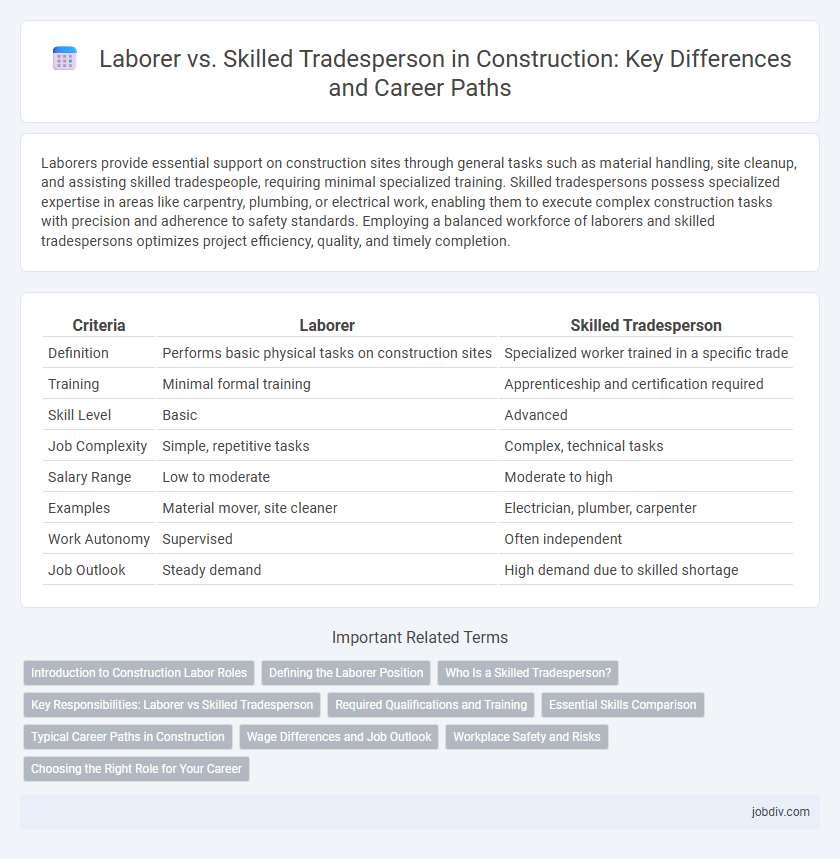Laborers provide essential support on construction sites through general tasks such as material handling, site cleanup, and assisting skilled tradespeople, requiring minimal specialized training. Skilled tradespersons possess specialized expertise in areas like carpentry, plumbing, or electrical work, enabling them to execute complex construction tasks with precision and adherence to safety standards. Employing a balanced workforce of laborers and skilled tradespersons optimizes project efficiency, quality, and timely completion.
Table of Comparison
| Criteria | Laborer | Skilled Tradesperson |
|---|---|---|
| Definition | Performs basic physical tasks on construction sites | Specialized worker trained in a specific trade |
| Training | Minimal formal training | Apprenticeship and certification required |
| Skill Level | Basic | Advanced |
| Job Complexity | Simple, repetitive tasks | Complex, technical tasks |
| Salary Range | Low to moderate | Moderate to high |
| Examples | Material mover, site cleaner | Electrician, plumber, carpenter |
| Work Autonomy | Supervised | Often independent |
| Job Outlook | Steady demand | High demand due to skilled shortage |
Introduction to Construction Labor Roles
Construction labor roles vary significantly between laborers and skilled tradespersons, with laborers performing general manual tasks such as site preparation, material handling, and cleanup. Skilled tradespersons possess specialized expertise in areas like carpentry, plumbing, or electrical work, requiring formal training and certification. Understanding these distinct roles ensures efficient project management and adherence to safety and quality standards on construction sites.
Defining the Laborer Position
A laborer in construction performs essential manual tasks such as site preparation, material handling, and basic equipment operation, supporting skilled tradespersons to maintain workflow efficiency. Their responsibilities require physical strength, stamina, and the ability to follow safety protocols, but typically do not demand specialized technical training or certifications. Understanding the laborer position is crucial for project managers to allocate resources effectively and ensure smooth coordination on construction sites.
Who Is a Skilled Tradesperson?
A skilled tradesperson possesses specialized training and expertise in specific construction fields such as carpentry, plumbing, or electrical work, often acquired through apprenticeships or vocational education. Unlike general laborers who perform basic physical tasks, skilled tradespeople execute complex projects that require precision, technical knowledge, and adherence to safety standards. Their advanced capabilities contribute to higher project quality and efficiency in construction environments.
Key Responsibilities: Laborer vs Skilled Tradesperson
Laborers perform essential tasks such as site preparation, material handling, and equipment operation to support construction workflows. Skilled tradespersons specialize in technical duties including carpentry, electrical work, plumbing, and masonry that require certification and advanced training. The distinction lies in the complexity of responsibilities, with laborers executing foundational support roles and skilled tradespersons managing precise, code-compliant installations and repairs.
Required Qualifications and Training
Laborers typically require minimal formal qualifications and often receive on-the-job training focused on basic construction tasks, safety procedures, and physical labor skills. Skilled tradespersons must complete specialized apprenticeships, certifications, or vocational training programs in trades such as carpentry, plumbing, or electrical work, ensuring proficiency in technical skills and compliance with industry standards. Licensing and continuing education are commonly required for skilled trades to maintain expertise and adhere to evolving building codes and regulations.
Essential Skills Comparison
Laborers perform general physical tasks requiring basic skills such as lifting, carrying, and site cleanup, while skilled tradespersons utilize specialized expertise in areas like carpentry, electrical work, or plumbing. Skilled tradespeople demonstrate proficiency in interpreting blueprints, operating advanced tools, and adhering to safety standards, reflecting higher technical knowledge. The essential skills gap directly affects project complexity, efficiency, and quality outcomes on construction sites.
Typical Career Paths in Construction
Laborers often begin with general physical tasks, gaining experience that may lead to specialization or entry-level operator roles, whereas skilled tradespersons pursue formal apprenticeships and certifications to master specific crafts like welding, plumbing, or electrical work. Skilled trades careers typically offer higher wages and opportunities for advancement into supervisory or project management positions due to their specialized expertise. Continuous education and hands-on training are essential in both paths, but skilled tradespersons usually experience faster professional growth owing to credential recognition and technical proficiency.
Wage Differences and Job Outlook
Laborers typically earn lower wages, with median hourly rates around $15 to $20, while skilled tradespersons such as electricians and plumbers command higher wages averaging $25 to $35 per hour due to specialized training. The job outlook for skilled tradespersons is stronger, projected to grow by 8% over the next decade, reflecting increased demand for technical expertise in construction projects. Laborer positions face steadier but slower growth at about 5%, often influenced by economic fluctuations and less job specialization.
Workplace Safety and Risks
Laborers face increased workplace safety risks due to repetitive physical tasks and exposure to hazardous materials, requiring strict adherence to personal protective equipment (PPE) protocols. Skilled tradespersons benefit from specialized training that enhances their ability to identify and mitigate complex safety hazards related to machinery and technical processes. Both roles demand comprehensive safety programs to reduce injury rates and ensure compliance with Occupational Safety and Health Administration (OSHA) standards.
Choosing the Right Role for Your Career
Choosing between a laborer and a skilled tradesperson depends on your long-term career goals and skill development. Laborers perform essential physical tasks on construction sites with minimal training, while skilled tradespeople require specialized education and certification in fields like carpentry, plumbing, or electrical work. Investing in skilled trades can lead to higher wages, job stability, and opportunities for advancement within the construction industry.
Laborer vs Skilled Tradesperson Infographic

 jobdiv.com
jobdiv.com